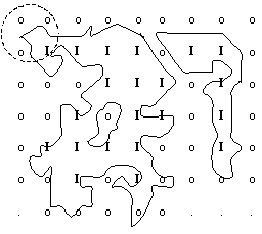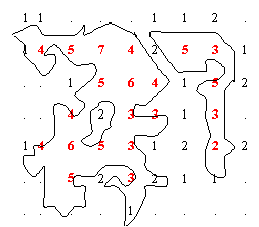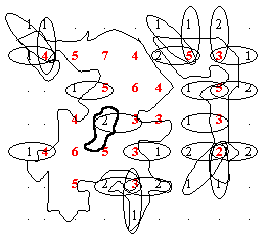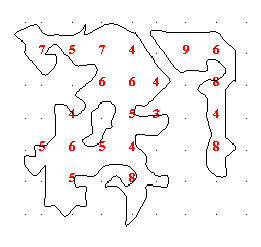Edge Effect in Forest Sampling (Part II)Kim Iles, Inventory Consultant Part I of this article covered the historical attempts to solve the problem of edge effect. Part II covers only one technique. This new method solves virtually all the shortcomings of previous methods, and does it without creating any mathematical complications. The method requires that the grid used is small enough. It is hard to imagine that this would not be true for normal pre-harvest cruising. The Situation
At each of these inside points, you would take a "full sweep" and count or measure any trees that are located inside the polygon. Ignore any trees that are outside the polygon. So far, of course, you have the classic problem of "edge effect" caused by tree circles that fall partly beyond the border of the polygon. One example of a very large tree circle (near the upper left edge) is shown with a dashed line. The Correction At each of these outside points, do a full sweep and again count or measure any trees inside the polygon that are "in" with your angle gauge. As before, ignore any trees outside the polygon. If a sample point falls into any "hole" in the polygon that is "typed out", it is still an "outside point." The key is what you do with these "extra" trees. This is straightforward. Just add the extra data from any outside point to any of the inside points. Treat the extra observations as if they had actually been seen from that inside point. Inside the tree circle on Figure #1, the same tree is "in" at 3 of the outside points. That tree would be recorded each time, and the 3 observations transferred to one (or several) of the inside points. Decide which sample points will be combined before you do the field work. If this is done, you can process the statistics as you usually do. The average is unbiased in any case. Once the data is added to the inside points, just process
the data in the normal way. Use the same procedure for inside and outside
sample points. You can also use a large BAF to choose sample trees, and a
smaller one to count trees as discussed in an earlier article on the "Big
& Little BAF" method. Figures 2, 3 and 4 show an example.
The Reasoning You can visualize the process by considering each of the grid points inside a square or rectangle. For points outside the polygon, imagine picking up the exterior part of the rectangle and dropping it over one of the interior rectangles. When these rectangles are matched, the sample points will fall on top of each other. All the outside parts of the tree circle are thereby moved "into" the polygon by this process. When this has been done for all of the rectangles, the entire area of all the tree circles is shifted into the polygon, and the "edge effect" has disappeared. All that needs to be insured is that there is at least one complete rectangle for these other areas to be "tossed back" over. Comments In addition, of course, you have to visit the extra sample points. There are some things you could do if the outside sample points were impossible to visit. Basically you just have to ask the question "could any of the trees be "in" on a sample point that far from the edge?" If so, you would have to compute the distance from the tree to that outside point. Alternatively, you could use one of the older methods described in the first part of this article for these situations. As far as I am aware, other than a few informal presentations by myself, this method has never been published. It is new, and I think it is a major improvement over previous methods of correcting for edge effect. While it is possible to extend this logic to sample points on large inventory projects, it would require that at least one sample point fell into each forest type. The technique is probably best adapted to cruises that use a grid and that sample individual polygons. |



